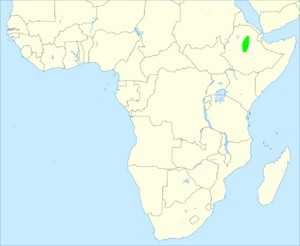Harwood's spurfowl facts for kids
Quick facts for kids Harwood's spurfowl |
|
|---|---|
| Conservation status | |
| Scientific classification | |
| Genus: |
Pternistis
|
| Species: |
harwoodi
|
 |
|
| geographic distribution | |
| Synonyms | |
|
|
The Harwood's spurfowl (Pternistis harwoodi), also known as Harwood's Francolin, is a special type of bird in the Phasianidae family. This bird is mostly grey-brown. It has a red beak and tail, and red skin around its eyes. Both male and female birds look similar, but the female is a bit lighter in color and has more buff (light yellowish-brown) on her belly.
This spurfowl lives only in Ethiopia. It can be found in the Ethiopian highlands, especially near the Blue Nile River. Scientists first thought these birds lived in specific plant areas like Typha beds or acacia bushes. However, studies in 1996 showed they can live in other places too.
The Harwood's spurfowl is considered Near Threatened. This means its population is decreasing, and it might become endangered if things don't change. Its home is shrinking because people need more land for farming and living. Also, these birds are hunted for food, and their eggs are collected. Sometimes, they are even caught to be sold in local markets.
Contents
About the Harwood's Spurfowl
Where it Lives
The Harwood's spurfowl is an endemic bird, which means it lives naturally in only one specific place. For this bird, that place is the Ethiopian highlands. You can find it on both sides of the Blue Nile River. Its home stretches between Lake Tana and where the Blue Nile meets the Jamma River. It also lives along the smaller rivers that flow into the Blue Nile in this area.
Why it is Threatened
The Harwood's spurfowl faces several dangers that threaten its survival. One big problem is habitat loss. As more people need land, they move into the wild areas where these birds live. This takes away the scrublands and bushes that the spurfowl uses for its home.
Another threat is hunting. People in the area often hunt the Harwood's spurfowl for food. Its eggs are also collected and eaten. Sometimes, the birds are caught and sold in local markets. These activities reduce the number of birds in the wild.
Naming the Harwood's Spurfowl
The Harwood's spurfowl was first described in 1899. Two English bird experts, Herbert Weld Blundell and Simon Fraser, 14th Lord Lovat, found a specimen of the bird in Ethiopia. They gave it the scientific name Francolinus harwoodi.
The second part of its scientific name, harwoodi, was chosen to honor Leonard Harwood. He was a taxidermist (someone who prepares animal specimens) and a naturalist who was active around 1899. Today, this bird is placed in the genus Pternistis. This genus was named by a German naturalist named Johann Georg Wagler in 1832.
Scientists have studied the bird's DNA to understand its family tree. A study in 2019 showed that the Harwood's spurfowl is closely related to Clapperton's spurfowl. The Harwood's spurfowl is considered a "monotypic" species. This means there are no different types or subspecies of this bird recognized.


